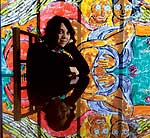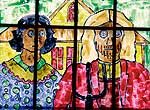Me and Jesus

K-Fai Steele '04 reflects on her exhibit, 'Me and Jesus', in Perry Atrium.
In a dazzling Perry Atrium installation, artist K-Fai Steele ’04 asks: “What if Jesus got the girl?”
by Doug Hubley
After scrutinizing traditional European representations of Jesus Christ during a junior year of study in Rome, art major K-Fai Steele ’04 returned to Bates determined to render Jesus in a way that would reflect aspects of American culture, just as Michelangelo or Titian did in 16th-century Italy.
Steele came up with a masterful stroke of cultural synthesis: If Hollywood is the temple of American pop culture and if the Hollywood romance a defining myth, what would happen if, after all these years, Jesus got the girl?
Steele’s gently satiric answer was expressed in a stunning week-long thesis exhibit in Pettengill Hall’s Perry Atrium last winter. Me and Jesus gave viewers much to consider, but made one thing clear: that a Bates student can have as much to say about a defining American moment — in this case, the sudden spike in our ongoing fascination with Christ — as anyone out there.
And that’s saying something, because it’s a crowded field these days, from the cinematic The Passion of the Christ, to novels like The Da Vinci Code, to a clutch of recent nonfiction social histories, like Stephen Prothero’s American Jesus: How the Son of God Became an American Icon.

A detail of a Steele painting in Perry Atrium.
Working with a crew from Facility Services and a hydraulic lift, Steele covered most of Perry Atrium’s massiveglass wall with 22 giant paintings in translucent media: house paint on plastic drop-cloths.
Steele remembered the visual effect of stained-glass images in European cathedrals, and her pieces in Perry similarly saturated the atrium with color — but socked viewers with scenes cathedrals never show.
Christ and the Girl in a photo booth. Christ and the Girl watching aliens build the pyramids. Christ and the Girl kissing under the mistletoe (happy birthday, honey!). Christ and the Girl as Barbie and Ken, Adam and Eve, Romeo and Juliet, the stoic couple in “American Gothic.”
“These are just snapshots of their relationship,” Steele says. The Girl started out as a self-portrait, but as the artist’s thinking evolved, Jesus’ love interest ultimately came to symbolize America itself. Through Me and Jesus, Steele sought to ask, “How do we make sense of Jesus now?”
To a distinctive extent, Americans want their icons and heroes, religious or not, to mirror their own hopes and worries. “It’s really important for Americans to actually identify with what they see,” says Professor of Religion Marcus Bruce ’77. “So there is an appropriation of Jesus, and people take him to mean what they want him to mean.”
It has less to do with theology, Bruce says, than with our urge to see Jesus in roles familiar to the American experience: “Jesus as hero, Jesus as renegade, Jesus as liberator, Jesus as warrior,” Bruce says. “Americans do that with their icons.”
Steele’s commentary came at a time when the media, and therefore the common U.S. consciousness, have been peculiarly saturated with Jesus — to the extent that “Jesus is my homeboy” T-shirts have had a turn as high Hollywood fashion. Me and Jesus was an especially captivating float in the parade.
“We are such a visual culture,” Bruce says. “We love films. We want to identify with a character and make the leap so we can be in that world.” Steele made that easier by rendering her scenarios as cartoons — funny, flattened, simplified, and vividly colored, thanks to the Disney-brand house paints that she used.
That visual style was important for another reason that involves the polite and respectful Bates culture, adds Steele’s adviser on the project, Pamela Johnson, assistant professor of art. “Sometimes saying things clearly and directly suffers [at Bates] because we are very driven to always be respectful and speak with civility and kindness. That can make it hard to just get at the broad, true thing. I think Me and Jesus was using a stripped-down, cartoon style as a quick, direct read.”
Civility and kindness prevailed, of course, although Steele likely would have liked more of a fuss than Me and Jesus ultimately got. “I would welcome the picketers with their pitchforks,” she joked — at a meeting she called to politely ask the campus’s permission to take over Perry for a week.
“She is a gracious provocateur,” Johnson says.
At any rate, if the style of Me and Jesus was cartoony, the content was satisfyingly layered: parodies of well-known artworks, inverted gender stereotypes, pop-culture cliches. (Crosses, meanwhile, were conspicuously absent.) Steele had questions and she wanted viewers to have some too.
“She was reconstructing, re-creating, reinterpreting,” Bruce says. “That process is very much at the core of religious traditions. It was about exploring an idea and a relationship, and providing an occasion for others to be reflective about it.”
In short, whatever the quality or quantity of your faith, for one January week you couldn’t be in Perry without thinking about Christ. “Part of me,” Bruce muses, “wishes Mel Gibson had done something more along these lines.”